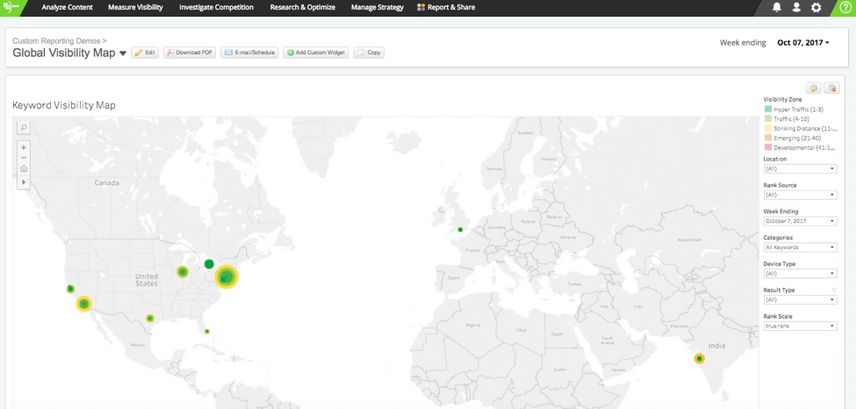Global Marketing Success Depends on Three Factors
When creating marketing strategies on a global level, where should you start? These three factors will decide the fate of your global marketing strategy.
For enterprise-level businesses operating on a global scale, there are a few make-or-break factors to consider when building out and implementing an international marketing strategy. It might seem at first like every market, region, or country has completely distinct needs. But as you expand your efforts, you'll want to create a centralized global marketing strategy that informs regional content. Easier said than done, right?
How to Create a Successful Global Marketing Strategy
When tackling global marketing, you'll see the most success if you focus in on three factors. These factors will inform your success both as you build out new global marketing efforts and expand on the ones you have in place. Let's take it one-by-one.
1. Do You Have the Right Balance Between Global and Regional Strategies?
Navigating the relationship between corporate headquarters and regional teams can be tricky, particularly when it comes to creating content that speaks to a specific audience’s needs and motivations. The key is to create a balance between your centralized global marketing strategy and your autonomous local teams.
To strike this balance, corporate HQ should provide a content strategy aligned with overarching business goals, but driven by regional information and insights. As you develop your process, remember: regional teams will look to headquarters to prioritize certain regions and market segments. In turn, headquarters will rely on regional leadership to understand the challenges of customers in specific markets.
Uniting Your Global and Regional Teams
Many global organizations rely on technology as a way to unite HQ and their regional teams. Integrating global marketing technology into your strategy can help your regional teams discover local customer insights, and report back on their findings to headquarters.
For example, technology like Conductor’s Global Visibility Map in our new FlexHub shows a global view of your company’s performance and allows you to quickly identify high-performing and under-performing markets. This performs a double function: it allows HQ to evaluate the efficacy of their global marketing strategy on a large scale and allocate enough resources for regional teams to succeed.

Where should you be investing your time and money? This global visibility report in the FlexHub shows where you are underperforming and the areas where you are poised to dominate.
2. Can You Easily Implement New Initiatives?
A lot of global companies struggle to implement new practices, as their existing systems are either too decentralized to unite behind one global marketing strategy, or too centralized to allow for region-specific campaigns. If this is the case for your team, you should begin shifting to a more balanced approach.
How can you do that? For the decentralized team, look to find a technology that can piece together the disparate efforts of your teams in a global view. Visualizing how each of your regional strategies come together is the first step in creating a centralized global marketing strategy.
For the overly centralized team, look for pilot markets to test how you roll out new initiatives. Start by prioritizing key strategic regions and growth opportunities and then address how your top-level global marketing strategy can be adapted to those markets.
When looking for pilot markets to test, global marketing technology can really lend a hand. In the FlexHub, for example, we offer an Emerging Markets report that can help corporations leverage new potential markets on a global scale. This report helps teams identify markets where their business can grow based on search volumeSearch Volume
Search volume refers to the number of search queries for a specific keyword in search engines such as Google.
Learn more data. As you look for pilot markets, focus on untapped areas where your potential customers are searching for your business or your solutions.

Search volume is a great way to determine what areas you should expand into. Here's a view from the FlexHub that showcases how much search volume there is in the U.S.
Don’t hesitate to start experimenting with the workflow between corporate HQ and regional teams. As you develop localized personas, new content types and topics, you’ll discover what works for the audience of your new market.
And as you build out to new markets, make sure to audit how your existing content is performing in your established areas. Not only will this help you uncover content gaps and opportunities in your existing areas, it will help you get ideas for strategies to tackle in new markets.
The key here is to ensure that regional teams are empowered with the flexibility and adaptability to try new things. The success of your entire global marketing strategy relies on your ability to communicate between your marketing teams. This will come from the top down, as corporate clarifies roles and responsibilities, and allocates budget to various regional teams.
3. Are You Communicating Effectively Across Teams?
Again, it all comes down to your ability to communicate. Communication is the single most important element of executing successful global marketing strategies. You’ll be most successful if you establish an effective feedback loop between HQ and local teams.
With an effective feedback loop, marketers working at headquarters can easily communicate high-level content strategy, share information across regional teams, and institute across-the-board rules and guidelines. This will also make it easier for regional content teams to inform headquarters of local data and insights, and report on their results.
As you move to implement your international marketing strategy, you’ll find that many of the existing tools you’re familiar with were built to address specific needs that might not apply to your global strategy. But there are other great options out there that are built for global marketing needs.
How Technology Can Help Meet Your Global Marketing Needs
One SEO tool that we’re a fan of is Dragon Metrics , a technology designed specifically for Asian markets. This is a best-in-class tool for any global company looking to unlock insights into the billions of potential customers in Asia. We love Dragon Metrics because it gives marketers the flexibility to look at their data in many ways and unlocks insights into the 1.4 billion potential customers in China who don’t search on Google, but use the Chinese search engineSearch Engine
A search engine is a website through which users can search internet content.
Learn more Baidu .

In fact, we’re such fans that we recently began a partnership with Dragon Metrics, allowing our global customers to gain insight into how audiences in Asia are looking for their products and services. If we’ve peaked your interest, you can learn a little more about our partnership with Dragon Metrics in this video.
We’ve been emphasizing this a lot, but technology is the single greatest asset in a successful global marketing strategy. By standardizing the way your team shares resources (be that calendars, campaign schedules, content, or data), you’ll have a much easier time implementing strategies.
So take your time finding the right tools. You’ll want a tool that allows for centralized access to creative assets and that make it easy to work across different languages, alphabets, and countries.
How You Can Begin to Develop Your Global Marketing Strategy
Where to start? Start by creating process by which you can share knowledge and results and build that process into the DNA of your organization and marketing teams.
At this point, C-Suite buy-in is essential. In fact, you should continuously communicate with your C-suite, providing data around the progress of your global marketing strategy. You should use holistic tools and reports, like the ones you can find in the FlexHub, to report to your CEO, CMO, and other stakeholders.
As you start to create your global marketing strategy, never forget that no matter how macro your strategy is, it will need to acknowledge the region-specific nuances in the way customers in different markets look for answers, solutions, and products online. As you scale up or expand into new markets, be sure that, no matter which processes you put in place or technology you decide to use, you have the ability to see both the forest and the trees.







